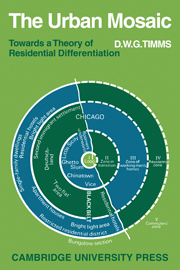Book contents
3 - The bases of residential differentiation
Published online by Cambridge University Press: 05 January 2012
Summary
The application of factor analytic techniques to urban residential differentiation has produced relatively consistent results. It seems rather well established that, at least in the Western world, much of the detailed variation in the characteristics of urban sub-communities may be interpreted in terms of three or four underlying constructs relating to differences in socio-economic status, in family composition, in ethnicity and in mobility. The demonstration of factorial invariance, however, is not to be equated with an explanation of factor structures. Having established the empirical validity of the major axes of residential differentiation the next step is to attempt the explanation of their significance and to examine the relationship they exhibit to other facets of human behaviour and social structure. It is to this task that the attention of this and of the next chapter are directed.
As is true in the case of many other sociological phenomena, the explanation of ecological structure may be attempted at either of two levels: a micro-social and a macro-social. In the micro-social approach attention is focused on the relationship between residential differentiation and patterns of individual decisions and behaviour. In the macro-social approach attention is focused on the relationship between residential differentiation and certain global characteristics of the encompassing society. A satisfactory theory of residential differentiation must include both approaches.
- Type
- Chapter
- Information
- The Urban MosaicTowards a Theory of Residential Differentiation, pp. 85 - 122Publisher: Cambridge University PressPrint publication year: 1971



